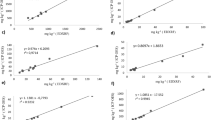Abstract
Potassium, in a variety of compounds, occurs in abundance in the Earth’s crust, and is an essential nutrient for human health. A naturally occurring radioactive isotope of potassium, 40K, is found in the food and water that we consume. This paper presents the results of a gamma spectrometry analysis of the 40K concentrations of a selection of commercial soft drinks. The 40K concentrations are used to calculate the overall potassium concentrations. The analysis was carried out using a hyper-pure germanium (HPGe) detector with Ortec® ASPEC-927 multichannel analyzer module and GammaVision® software. This system was chosen for its high resolution and automatic data processing. The carbonated soft drinks (sodas) Coca-Cola®, Coca-Cola Light® (sold as Diet Coke® in the USA and other countries), Coca-Cola Zero®, Pepsi®, Pepsi Light®, Pepsi Max®, Big Cola®, Lulu-Cola®, Manzana Lift®, Sprite® and Fanta® and the mineral waters Ciel® and Peñafiel® were analyzed. These brands are all international registered trademarks. The products analyzed were manufactured and bottled in Mexico. The results show a great variety of potassium concentrations in the different soft drinks analyzed (from 128.0 to 1113.1 mg/L). The concentration of potassium in the sodas, in conjunction with the amounts drank by one person in a year (180 L/year), are high enough to warrant consideration by public health authorities and by people to whom high potassium intakes pose a risk.
Similar content being viewed by others
References
Federal-Provincial-Territorial Committee on Drinking Water (February, 2007) Potassium in drinking water. http://www.hc-sc.gc.ca/ewh-semt/alt_formats/hecs-sesc/pdf/pubs/water-eau/consultation/potassium/potassium-eng.pdf. Accessed March 24, 2009
Maria de Los Angeles Avila Soto (1999) ¡Que refrescos! (¡which kind of soft drinks!) Letere en linea, UVAQ, http://www.uvaq.edu.mx/letere/articulo.php?articulo=7&numletere=81&seccion=6. Accessed March 24, 2009
Amedec (1999) http://www.sunsonline.org/trade/process/followup/1999/09020599.htm. Accessed March 24, 2009
Nir-El Y (1997) Practitioner’s report, 2, pp 193–198
Human Health Fact Sheet (August, 2005) Argonne National Laboratory, EVS
Navarrete JM (2005) Nuclear analysis. Measurement on the Road to Food Safety-1, p 836
Navarrete JM, Campos J, Martínez T, Cabrera L (2005) J Radioanal Nucl Chem 265:133–135
Espinosa G (June, 2007) Notes of the fifth Mexican nuclear physics school. Mexican Physics Society
Vega Carrillo HR, Iskander FV, Manzanarez-Acuña E (2002) J Radioanal Nucl Chem 252:75
Acknowledgements
The authors wish to thank to A. García, A. Huerta and D. Aguilar for their technical help. This work was partially supported by PAPIIT-DGAPA-UNAM grant 1N107707.
Author information
Authors and Affiliations
Corresponding author
Rights and permissions
About this article
Cite this article
Espinosa, G., Hernández-Ibinarriaga, I. & Golzarri, JI. An analysis of the potassium concentrations of soft drinks by HPGe gamma spectrometry. J Radioanal Nucl Chem 282, 401–404 (2009). https://doi.org/10.1007/s10967-009-0139-y
Received:
Accepted:
Published:
Issue Date:
DOI: https://doi.org/10.1007/s10967-009-0139-y




